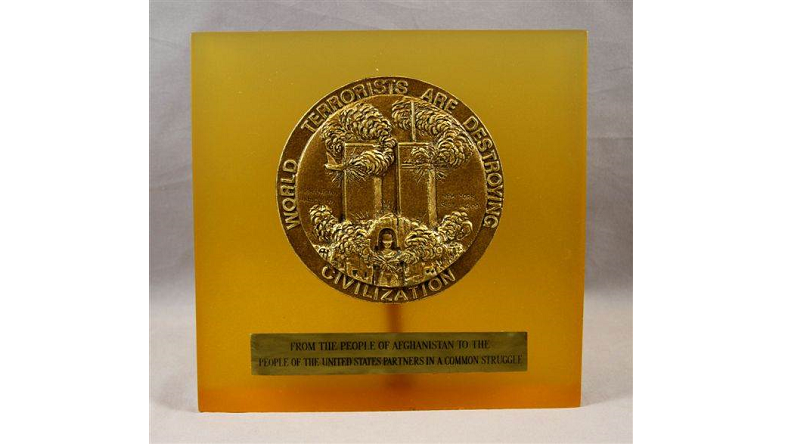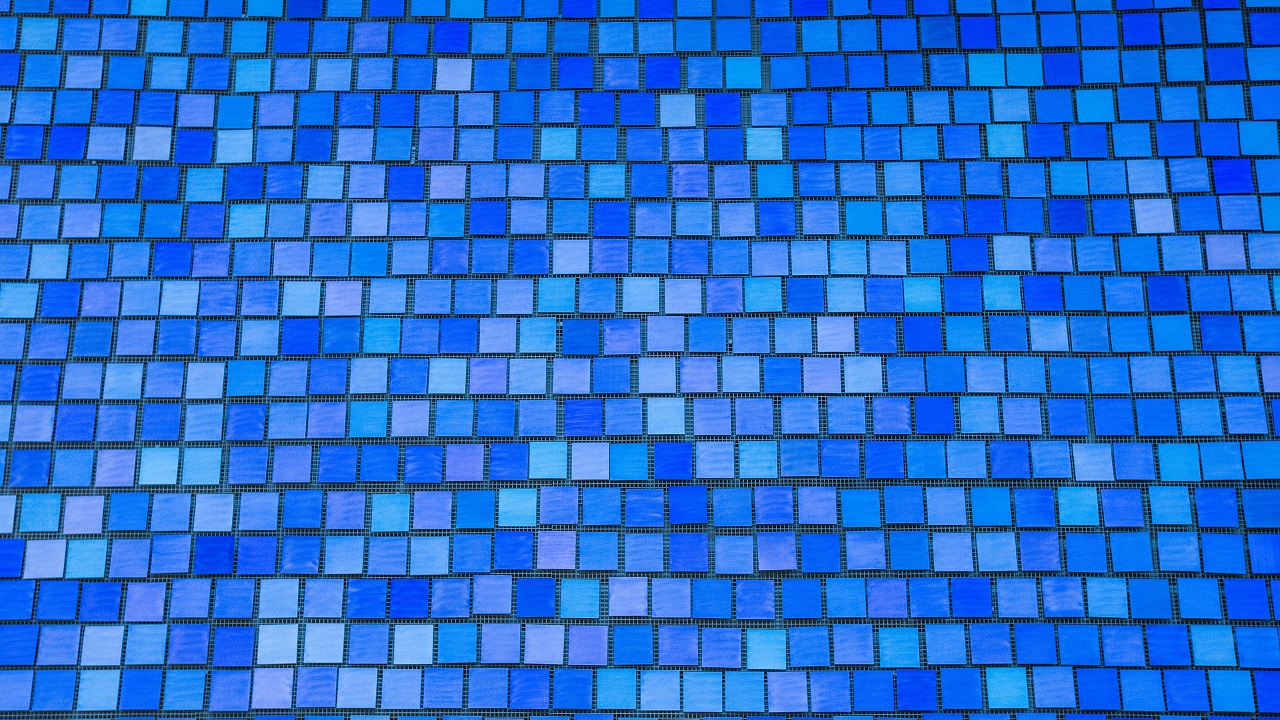Reflecting on the Afterlives of the Bamiyan Buddhas and Twin Towers
Reflecting on the Afterlives of the Bamiyan Buddhas and Twin Towers

This past October, after several cancellations tied to the COVID-19 pandemic, a meeting finally solidified with the multimedia artist Andra Samelson. Almost a year earlier, she had contacted the 9/11 Memorial Museum about a gift she wished to make “in honor of those who were killed when the Twin Towers were destroyed.”
Toting hand sanitizer and face masks, two of us from the Collections staff ventured to Samelson’s studio space on Wooster Street where we spent more than an hour in her company, discussing and admiring the paintings (titled “Shamama” and “Kakrak”) she was proposing to donate. Conceived as a diptych, her tribute was not an interpretation of the two, silver-clad skyscrapers deleted from New York City’s skyline on 9/11, a theme surfacing frequently in the aftermath of their loss. Instead, these paired works depicted gold-toned images of the sixth century B.C. Buddha seated at rest. In turn, these had been superimposed on the ghostlike, vertical figures of two colossal, standing statues of Buddha carved into the sandstone cliffs of Afghanistan’s Bamiyan Valley.

Amy Weinstein, Senior Curator of Oral History & Vice President of Collections, standing next to Andrea Samelson's Buddhas in October 2020
Deprived of historical context, Buddhas from the ancient Silk Road may seem poles apart from the World Trade Center near Wall Street, just as personal meditation may seem incongruous with corporate capitalism. But the parallelism had a logic traceable to events that had transpired six months apart in 2001, in central Afghanistan and in lower Manhattan, a mile from Samelson’s Soho workplace. Indeed, we had seen this visual connection made previously, my introduction to it datable to the initial stage of drafting the Museum’s core narrative.
During that iterative process, ideas and leads to the material were volunteered by innumerable individuals and groups. One early, memorable exchange took place over tea, in a midtown hotel, with Said Tayeb Jawal, then serving as Afghanistan’s Ambassador to the United States. A consummate diplomat, he conveyed his country’s deepfelt condolences over this mass atrocity against humanity. The obliteration of New York City’s renowned Twin Towers by al-Qaeda was no less shocking than the Taliban’s methodical sabotaging of the two ancient Bamiyan Buddhas six months before 9/11, he remarked. Did we recall that interim Afghan leader Hamid Karzai had paid his respects at Ground Zero on a trip to the United States in late January 2002, prior to his official election as President of Afghanistan? While standing on a riser overlooking the devastation, he had emphasized the Afghans' special understanding of America’s pain. Were we aware of the special gift that Karzai had presented to President George W. Bush, manifesting that shared sympathy and sorrow?
We knew of Hamid Karzai’s pilgrimage to Ground Zero. Many world dignitaries visited the site during those mournful months after September 11. But, unaware of the offering he brought to the president, that tip merited pursuit. In the wake of 9/11, expressions of condolence, offers of assistance, and condemnations of terrorist violence had flooded into the United States via mail, heads of state, and diplomatic emissaries. These were received by representatives of the nation, localities, and first responder groups reflected in the day’s tally of victims.
For the core history exhibition under development, an idea had taken hold of assembling a select survey of such immediate tokens and proclamations. These would emphasize the international solidarity kindled by the brutality of the attacks, even if some of that comity later receded. For display purposes, we sought objects of varying sentiments and material form. Ireland’s president, for example, had commissioned the venerable Waterford factory to create undulating tabletop American flags made from glass for presentation to the affected uniformed rescue agencies. The Republic of India had crafted a silver urn filled with water from the country’s nine sacred rivers, delivered through the office of Mayor Guiliani to the citizens of New York. The scourge of terrorism familiar to both countries imbuing these gestures with added understanding.
After a year’s tracking, Karzai’s 2002 offering brought to America was found, on hold for the future George W. Bush Presidential Library and Museum in Dallas. Generously, its staff agreed to lend this remarkable artifact to the still-unopened 9/11 Memorial Museum. Produced as a resin plaque with a centering metal bas-relief, the piece offers an almost cinematic tableau depicting the modernist Twin Towers above one of the monumental statues of the ancient Buddha, as both landmarks are under bombardment halfway around the globe from one another.
Smoke erupts from their wounds. The North Tower is already on fire. A passenger jet has torpedoed into the South Tower, its rear fuselage not yet absorbed. Below, within a cliffside niche, the Buddha’s torso has been mauled. The dates and locations of these separate 2001 atrocities—March 2 and September 11—are inscribed at the composition’s left and right. Around the edge, in the present tense, is the point-blank statement, “World Terrorists Are Destroying Civilization.” A dedication below the medallion reads, “From the People of Afghanistan to the People of the United States, Partner in a Common Struggle.” For the receiving audience, the plaque dramatized a distant threat brought all-too-near and abruptly, to the American homeland.
Driven by similar extremist ideologies and shock-value aims, these catastrophes were not the work of the same perpetrators. Nor were they equal as events. The burning steel and glass skyscrapers in lower Manhattan collapsed in 102 minutes on a singular morning. Twenty-five days of dynamite, tank shells, and artillery were required to pulverize the sandstone-hewn Buddhas. (Arab and Pakistani explosive experts reportedly aided the mission.) Al-Qaeda executed a coordinated stealth attack; Taliban militants announced in advance their objective of destroying these ancient effigies. The towers were human-occupied; the Buddhas were inanimate, spiritual carvings.
But the acts also had many commonalities. They targeted symbols of heritage (Afghanistan’s pre-Islamic past, in March 2001) and cultural identity (America’s global economic influence, military strength, and revered western democracy, on 9/11) and created intentionally horrifying spectacles to humiliate and erode public morale. Each drew international attention to the manifestos of those responsible. In retrospect, the assault on the Buddhas was seen by many as a harbinger of the attacks on the Twin Towers. From 2001 forward, that mode of violence recommenced with more deadly strikes by al-Qaeda and the rise of the Islamic State terrorist organization whose fighters destroyed holy sites and antiquities in Iraq and Syria while murdering thousands of civilians and military service members in the Middle East, Europe, and elsewhere. As in the Bamiyan Valley, lower Manhattan, Palmyra, Mosul, and too many other affected places, the aftermath of destruction compelled deep communal soul-searching about how to commemorate such losses, the implications of preserving absence, and whether, when, or in what manner to repair the ruins.
Comments by Andra Samelson come to mind from last fall’s studio visit. Although the two ancient Buddha sculptures were gone, she reflected, their demolishment invigorated worldwide appeals for religious tolerance. The timeless ideas of Buddhism had survived. Her melding of the absent Bamiyan Buddhas and Twin Towers artistically honored the endurance of their respective memories as well as humankind’s indestructible quest for peace. Two decades after those irrecoverable sculptures were erased, such sentiments speak to the strength of their afterlife. This may be the positive forecast for the 20th-year observance of 9/11.
By Jan Seidler Ramirez, Chief Curator and Executive Vice President of Collections, 9/11 Memorial & Museum
Previous Post
Next Post
Looking Back at 2020: The 9/11 Memorial & Museum Annual Report

The 9/11 Memorial & Museum released its annual report, which provides a snapshot of our efforts to inspire, educate, and commemorate over the course of 2020.